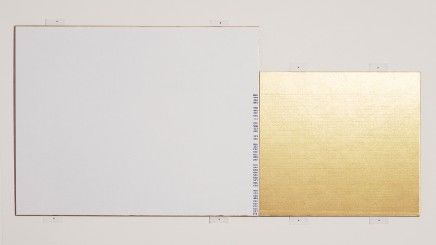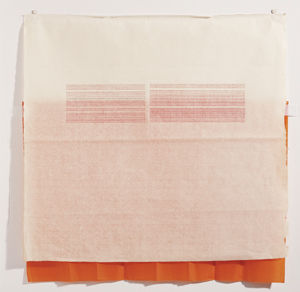
Hammer Projects: Frances Stark
- – This is a past exhibition
Frances Stark's Hammer Project consists of a sixteen-work series collectively titled The Unspeakable Compromise of the Portable Work of Art. Stark's project engages with Daniel Buren's early 1970s writings on "the art system," the various public and private spaces through which art objects circulate. The drawings, collages, sculptures, and textual commentary that comprise this series date from 1998 to the present and have never been exhibited together before now. Stark is also a well-known writer, and each piece is accompanied by her witty, personal, and self-consciously ruminative texts, which often directly address the owner of the work or the preparators who install it. Claudine Isé says, "Taken as a whole, these writings reflect upon the projection of meaning and symbolic value onto the artworks by Stark herself as well as the gallerists, curators, collectors, art handlers, and others who encounter these objects in a variety of contexts."
This Hammer Project was curated by Claudine Isé, assistant curator.

Biography
Frances Stark was born in 1967 in Newport Beach, California, and lives and works in Los Angeles. She received her M.F.A. in 1993 from Art Center College of Design. She has had solo exhibitions at greengrassi, London; CRG, New York; Marc Foxx Gallery and China Art Objects, Los Angeles; Galerie Paule Anglim, San Francisco; Kunstverein Galerie, Munich; and Galerie Daniel Buchholz, Cologne. Her work has been included in group exhibitions at the CCAC Institute, San Francisco; the San Francisco Museum of Modern Art; the Los Angeles County Museum of Art; and the Museum of Contemporary Art, Los Angeles, among others. She is the author of The Architect and the Housewife (Book Works, 1999). This Hammer Project is Stark's first solo museum exhibition in the United States.
Essay
By Claudine Isé
The Unspeakable Compromise of the Portable Work of Art (1998-2002) is a series of sixteen works by Frances Stark that collectively engage the artist Daniel Buren's 1971 essay "The Function of the Studio."1 Buren sought to reveal the ideological support systems that structure how paintings (the "portable works" to which he refers) are understood and how the appearance of a painting on a museum's walls in turn frames the institutions that safeguard works of art. The artwork's "unspeakable compromise," as Buren sees it, arises from the fact that when it is taken from the studio and placed within the museum or gallery, it is divested of its history, its context, and ultimately of its own specificity. Buren's memorable phrase has made a number of appearances in Stark's work, including one in her book The Architect and the Housewife (1999). But it is in her Unspeakable Compromise series that Stark's ongoing tête-à-tête with Buren begins to take on a life of its own. These works, which were made over a period of several years, have never been exhibited together before now. This Hammer Project, which includes a number of new works, thus marks the series' culmination. It also provides a unique opportunity to consider Stark's drawings and her writings side-by-side, as overlapping and mutually informing discursive channels.
Stark is probably as well known for her published writings, which fold cultural observation and textual analysis into the conventions of the personal essay, as she is for her visual art. Her drawings and collages are made up almost entirely of writing, usually short phrases quoted from literary or cultural sources and copied laboriously by hand in stacked, repeating lines of text. Neither form of production is privileged over the other, and in both, Stark is broadly concerned with the arbitration of differences-in other words, with the art of compromise. Subtly weaving together a number of different ideas, contexts, and personal and literary references, she demonstrates how two or more seemingly contradictory or unrelated concepts actually inform one another to a startling degree. When reading her texts, one quickly takes note of her peculiarly roundabout way of getting to her point, a kind of decentered and horizontal movement through disparate ideas and discontinuous strategies that, far from going nowhere, allows her to consider various possibilities at once.
Stark's Unspeakable Compromise series contains a number of carbon text-drawings on sheets of rice paper that have been fitted with pleated tissue paper “skirts” in pert shades of tangerine, lemon, and Chinese red, among others. “Think of the painted, smaller piece of paper as a slip accentuating the top garment,” writes Stark in an installation note that accompanies number 9. The skirts are accessories that have no real function other than to add splashes of color and hints of cocktail-party glamour to these otherwise reticent works. Yet they also coyly allude to Buren's assertion that the artist's studio is made to function like a boutique selling ready-to-wear clothing: the curator or collector visits the studio, selects the pieces that he or she wants, and leaves with a work of art that can be placed in any number of new contexts over which the artist has little or no control.
For Buren the work's exile from the studio condemns it to a life of abject adornment, a situation that he sought to rectify in his own practice by stripping his paintings of all "content," as well as any formal element that he considered excessive, in order to focus the viewer's attention on the transparent fact of the painting's existence. Stark's repetitive transcriptions and repeated references to the Buren text echo these strategies, but in her hands the effort is tinged with the sensual (through the act of tracing another's words by hand) as well as the personal and the social (in her use of direct address and her sharing of personal memories and anecdotes).
An altogether different take on portability is seen in Stark's two sculptural works. Number 12 consists of plaster stilts made as a thank-you gift for the German clothing designers Loy & Ford, who gave Stark a jacket from their studio in Los Angeles's Chinatown, simply because she liked it so much. Number 11 is a red chair that, displayed on four white plaster stilts, brings to mind Joseph Beuys's 1981 Terremoto in Palazzo, an installation that includes a wooden sawhorse whose legs rest uneasily on four glass jelly jars. The Beuys piece commemorates a 1980 earthquake that destroyed an entire city not far from Naples. Stark's China red chair makes reference to a far less tragic but nonetheless personally significant instance of extinguished context: the closing of the oldest Chinese restaurant in Los Angeles, General Lee's originally called Man Jen Low), which was located around the corner from her studio. In an accompanying installation note, Stark remarks that when she took the chair, General Lee's had been closed for twenty years. It was slated to reopen as a bar, and in the meantime, part of it was being used as a studio/woodshop by the artist Jorge Pardo, who cut up the chair in order to make it easier for Stark to ship it overseas.
Stark's installation notes are a critical component of the series (a selection are included in the UCLA Hammer exhibition). They are at once condition reports, personal anecdotes, and tongue-in-cheek “certificates of authenticity.” Although the texts provide directions for the works' handling and care and sometimes a brief history of their genesis, their ruminative nature, literary sophistication, and subjective mode of address make them seem less like instruction manuals and more like prose, although in essence they are both of these things. These typed or handwritten notes restore to Stark's works the context they lose when removed from the studio-but only partially. Riddled with her hand-scrawled marginalia, Post-it notes, snapshots, crossed-out passages, and “useless” diagrams, the notes make it clear that nothing is ever self-evident and that even an artist's most diligent effort to communicate directly with her audience risks going astray.
The sixteenth and final work in the series is a limited edition, self-produced catalogue that reproduces some of these installation notes and includes a new essay by Stark. The series thus culminates in a book—“the most portable object of all time,” as Stark has observed2—whose content is generated by the works that precede it. In this way, the series can be seen as a kind of self-generating system that is perpetually reconfiguring itself.
Stark's UCLA Hammer exhibition recontextualizes her "unspeakable compromises" in still other ways. The works are displayed in an exhibition space commonly referred to as the Vault Gallery, which was originally designed to house the Codex Leicester, an illustrated scientific manuscript that Leonardo da Vinci composed between 1506 and 1508. A diary-like, handwritten record of ideas, trials, and speculations, the codex is at once a work of art and a scientific document, text and context rolled into a quintessentially portable object-one whose significance has changed considerably in the centuries since Leonardo made it. Talk about a shifting context-and ultimately, not an inappropriate one for Stark, for whom meaning and context are nothing if not portable.
Notes
1. Daniel Buren, “The Function of the Studio,” October 10 (fall 1979): 51-58.
2. Frances Stark, The Architect and the Housewife (London: Book Works, 1999), 17.
Claudine Isé is an assistant curator at the UCLA Hammer Museum.
Hammer Projects are made possible, in part, with support from The Horace W. Goldsmith Foundation and The Andy Warhol Foundation for the Visual Arts. Additional support has been provided by the Los Angeles County Art Commission and the Pasadena Art Alliance.







